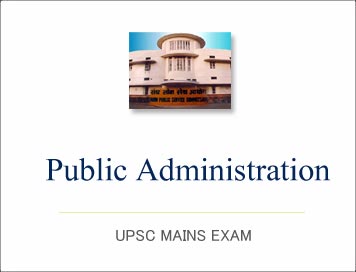
(Exam Paper) UPSC IAS Mains 2010: Public Administration
Paper- I
Section A
1. Answer any three of the following questions in not more than 200 words each: 20 × 3 = 60
(a) “Not merely governance but good governance is the key factor in achieving the United Nations Millennium Goals (2000).” Explain.
(b) “In McGregor’s view, the managerial cosmology meaningfully addresses the understanding of manager and his role perceptions.” Explain.
(c) “The successful management leaders are found in Likert’s ‘System-4’ approach to organizational leadership.” Examine.
2. (a) “Simon’s identifying decision-making as the core field of public administration appears logical ,acceptable_ but his positivist underpinning is problematic.” Critically examine the statement.
(b) “New Public Management is dead; long live digital era of governance.” Comment.
3. Discuss the impact of privatisation on public administration with special reference to: 20 × 3 = 60
(a) the issue of users must pay
(b) the Public Private Partnership
(c) Outsourcing technique
4. Examine the basic principles underlying citizen’s charter 20 × 3 = 60
With special reference to
(a) Its administrative philosophy
(b) Promoting public accountability
(c) Ensuring standards of public service
Section B
5. Answer any three of the following questions in not more than 200 words each: 20 ×3 =60
(a) “The concept of development is multi-dimensional and ever-expanding.” Explain.
(b) “The Prismatic model of Riggs is equally applicable to developing as well as developed society.” Comment.
(c) “The market has become the new icon of developmentalism.” Comment.
(d) “Public administration can be portrayed as a wheel or relationships focused on the formulation and implementation of public policy.” Explain.
6. (a) Explain the ‘Peter Principle’ in respect of promotion policy in a hierarchical organization.
(b) Discuss in the connection the case for and against promotion based on seniority.
7. (a) Distinguish fully between the syndicate method, role playing method, and T-Group taining method in personnel management.
(b) Do you think that there is a sort of paradox between e-Governance and good governance? Explain fully.
8. (a) Distinguish between PPBS and performance budgeting.
(b) Briefly discuss the principles of ensuring ethics in public service as recommended in the Nolan Committee Report (1994).
(c) “Cost-benefit analysis is a very unsatisfactory view of evaluating public policy.” Comment.

Paper- II
Section A
Attempt the following in not more than 200 words each: 3 × 20 = 60
1. (a) “The rule of kings depends primarily on written orders….” Why did Kautilya favour Codification of Laws?
(b) Is it correct to state that “One of the major reasons for the failure of many ….public sector undertakings was due to departures from the original concept of autonomy”?
(c) Does the emergence of an Empowered group of Ministers at the central level impair the doctrine of cabinet responsibility?
2. (a) It is said that the British made a significant contribution towards modernizing the Indian Administrative System on a ‘rational-legal’ basis. Justify the assessment with reference to the period from 1830 to 1865. 30
(b) Comment on the following statements: 30
(i) “The more developed an administrative system become the greater the likelihood that it would have developmental affects.”
(ii) “The thrust of development administration failed to energise the Indian bureaucracy.”
3. (a) With reference to India, discuss the assertion that administrative reforms are multi-dimensional and need to be substantiated by reforms in other related areas of state action. 30
(b) The prevalence of multiple channels for transfer of resources from the Centre to the State is stated to have compounded the problems of federal fiscal arrangements. Discuss. 30
4. (a) “In an era of hung parliaments the power of the President expands, more so when the incumbent decides to be assertive.” Comment on the statement with reference to the situation in India during the last two decades. 30
(b) “….Judges and Courts have creatively reinterpreted their statutory authority and expanded their own power and enhanced their standing vis-à-vis the legislature and executive.” Critically examine this assessment. 30
Section B
5. Comment on any THREE of the following in not more than 200 words each: 3 × 20 = 60
(a) “Public Interest Litigation (PIL) has undergone several changes since its inception in 1980s.”.
(b) “Civil service neutrality is a fiction. How any thinking person can be neutral?”
(c) States with a record of good governance, it is argued by spokespersons of some nce Commission’s award.
6. (a) Explain the context and perspectives of the following statements: 30
(i) The Planning Commission is “an armchair adviser”.
(ii) The Planning Commission should reinvent itself as a systems reforms commission in the backdrop of changed global and domestic scenarios.
(b) The Second Administrative Reforms Commission, in its 10th Report, observes that “the common perception is that the incentive structure in government tis too weak and inadequate to motivate better performance.” Elucidate. 30
7. Comment on each of the following in not more than 200 words each:
(a) “Non-Governmental Organisations play a catalytic role in enabling communities to define their own priorities….”
(b) The optimism expressed by the proponents of the Financial Rsponsibility and Budged Management Act, 2003, in ensuring fiscal discipline appears to be unwarranted.
(c) “The Jawaharlal Nehru National Urban Renewal Mission (JNURM) is one of the bigges reforms-linked development programmes taken up by the Government.”
8. (a) It is argued that the Bhopal gas disaster and the response pattern to it reflect multiple vulnerabilities relating to systems of corporate social responsibility, governance at local, state and central levels, and legal safeguards and liabilities.
Comment on this assessment. 30
(b) With the creation of new regulatory agencies in the wake of liberalization, overlapping jurisdictions and conflicts became the new trend. Is there need for the creation of a super-regulator or unified regulator? 30